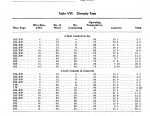HeavyDuty123
Member
- Location
- United States
attached is the 1956 proposal, right side middle of third page.
“Also in connection with this table, the utility people pointed out that aluminum wire for services was being modified from the 84 per cent value previously given in the Code, that is 84 per cent of the copper carrying capacity, and while they were in agreement with that because the data was the result of a study by the sub-committee, they did want to point out that in a 3-wire single phase, with only one of the wires loaded, it would not be necessary to go to the higher values.
It was proposed that a note be made for 2 to 4/0, the allowable capacity, it would be one, the 84 percent value, and these values were ironed out by the Correlating Committee to values normally used by the Code so that for #2, 100 amperes; #1, 110 amperes; for #0, 120. That, too, was adopted by the Correlating Committee. There were minor editorial changes but those are the changes in substance."
also attached is 1953 NEC pages, page 7 note one shows how all aluminum was sized originally, 84%
also attached are 1956 NEC pages, page 4 table note is where this allowance was originally and it was for all single phase services not just residential
I appreciate the input and information
“Also in connection with this table, the utility people pointed out that aluminum wire for services was being modified from the 84 per cent value previously given in the Code, that is 84 per cent of the copper carrying capacity, and while they were in agreement with that because the data was the result of a study by the sub-committee, they did want to point out that in a 3-wire single phase, with only one of the wires loaded, it would not be necessary to go to the higher values.
It was proposed that a note be made for 2 to 4/0, the allowable capacity, it would be one, the 84 percent value, and these values were ironed out by the Correlating Committee to values normally used by the Code so that for #2, 100 amperes; #1, 110 amperes; for #0, 120. That, too, was adopted by the Correlating Committee. There were minor editorial changes but those are the changes in substance."
also attached is 1953 NEC pages, page 7 note one shows how all aluminum was sized originally, 84%
also attached are 1956 NEC pages, page 4 table note is where this allowance was originally and it was for all single phase services not just residential
I appreciate the input and information




